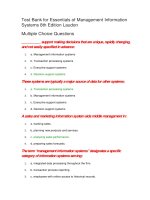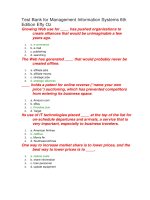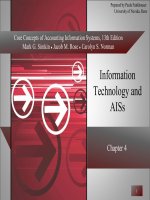Enterprise manage information systems 6th by laudon ch10
Bạn đang xem bản rút gọn của tài liệu. Xem và tải ngay bản đầy đủ của tài liệu tại đây (560.1 KB, 57 trang )
Chapter 10
Essentials of Management Information Systems, 6e
Chapter 10 Enterprise Applications and Business Process Integration
Enterprise Applications and Business
Process Integration
10.1
© 2005 by Prentice Hall
Essentials of Management Information Systems, 6e
Chapter 10 Enterprise Applications and Business Process Integration
Objectives
1. How do enterprise systems provide
value for businesses? How does
enterprise software work?
2. How do supply chain management
systems provide value for businesses?
What does supply chain management
software do?
10.2
© 2005 by Prentice Hall
Essentials of Management Information Systems, 6e
Chapter 10 Enterprise Applications and Business Process Integration
Objectives
3. How do customer relationship management
systems provide value for businesses? What
does customer relationship management
software do?
4. How can enterprise applications be used in
platforms for new cross-functional services?
5. What are the challenges of implementing and
using the various enterprise applications?
10.3
© 2005 by Prentice Hall
Essentials of Management Information Systems, 6e
Chapter 10 Enterprise Applications and Business Process Integration
Management Challenges
1. Thinking beyond the walls of corporation
2. Obtaining value from enterprise
applications
10.4
© 2005 by Prentice Hall
Essentials of Management Information Systems, 6e
Chapter 10 Enterprise Applications and Business Process Integration
Enterprise Systems
How Enterprise Systems Work
• Enterprise Software: Set of integrated
software modules for finance and
accounting, human resources,
manufacturing and production, and sales
and marketing that allows data to be used
by multiple functions and business
processes
10.5
© 2005 by Prentice Hall
Essentials of Management Information Systems, 6e
Chapter 10 Enterprise Applications and Business Process Integration
Enterprise Systems
Enterprise system architecture
Figure 10-1
10.6
© 2005 by Prentice Hall
Essentials of Management Information Systems, 6e
Chapter 10 Enterprise Applications and Business Process Integration
Enterprise Systems
Process map for procuring new equipment
Figure 10-2
10.7
© 2005 by Prentice Hall
Essentials of Management Information Systems, 6e
Chapter 10 Enterprise Applications and Business Process Integration
Enterprise Systems
How Enterprise Systems Work
• Best Practices: The most successful
solutions or problem-solving methods for
consistently and effectively achieving a
business objective
10.8
© 2005 by Prentice Hall
Essentials of Management Information Systems, 6e
Chapter 10 Enterprise Applications and Business Process Integration
Enterprise Systems
Benefits and Challenges of Enterprise Systems
Benefits of Enterprise Systems
• Firm Structure and Organization: One
Organization
• Management: Firmwide Knowledge-Based
Management Processes
10.9
© 2005 by Prentice Hall
Essentials of Management Information Systems, 6e
Chapter 10 Enterprise Applications and Business Process Integration
Enterprise Systems
Benefits and Challenges of Enterprise Systems
Benefits of Enterprise Systems
• Technology: Unified Platform
• Business: More Efficient Operations and
Customer-Driven Business Processes
10.10
© 2005 by Prentice Hall
Essentials of Management Information Systems, 6e
Chapter 10 Enterprise Applications and Business Process Integration
Enterprise Systems
Benefits and Challenges of Enterprise Systems
Enterprise System Challenges
• Daunting Implementation
• High Up-Front Costs and Future Benefits
• Inflexibility
• Realizing Strategic Value
10.11
© 2005 by Prentice Hall
Essentials of Management Information Systems, 6e
Chapter 10 Enterprise Applications and Business Process Integration
Supply Chain Management Systems
Supply Chain Processes
• Plan: Balances aggregate demand and
supply to develop a course of action
• Source: Processes that procure goods and
services needed to create a specific product
or service
• Make: Processes that transform a product
into a finished state to meet planned or
actual demand
10.12
© 2005 by Prentice Hall
Essentials of Management Information Systems, 6e
Chapter 10 Enterprise Applications and Business Process Integration
Supply Chain Management Systems
Supply Chain Processes
• Deliver: Processes that provide finished
goods and services to meet actual or
planned demand
• Return: Processes associated with
returning products or receiving returned
products
10.13
© 2005 by Prentice Hall
Essentials of Management Information Systems, 6e
Chapter 10 Enterprise Applications and Business Process Integration
Supply Chain Management Systems
Key supply chain management processes
Figure 10-3
10.14
© 2005 by Prentice Hall
Essentials of Management Information Systems, 6e
Chapter 10 Enterprise Applications and Business Process Integration
Supply Chain Management Systems
Supply Chain Processes
• Logistics: Planning and control of all
factors that will have an impact on
transporting a product or service
10.15
© 2005 by Prentice Hall
Essentials of Management Information Systems, 6e
Chapter 10 Enterprise Applications and Business Process Integration
Supply Chain Management Systems
Information and Supply Chain Management
• Just-in-Time: Scheduling system for
minimizing inventory by having components
arrive exactly at the time they are needed and
finished goods shipped as soon as they
leave the assembly line
• Bullwhip Effect: Distortion of information
about demand for a product as it passes
from one entity to the next across the supply
chain
10.16
© 2005 by Prentice Hall
Essentials of Management Information Systems, 6e
Chapter 10 Enterprise Applications and Business Process Integration
Supply Chain Management Systems
The bullwhip effect
Figure 10-4
10.17
© 2005 by Prentice Hall
Essentials of Management Information Systems, 6e
Chapter 10 Enterprise Applications and Business Process Integration
Supply Chain Management Systems
Supply Chain Management Applications
• Supply Chain Planning Systems: Enable a
firm to generate demand forecasts for a
product and to develop sourcing and
manufacturing plans
• Demand Planning: Determining how much
product a business needs to make to
satisfy all its customers’ demands
10.18
© 2005 by Prentice Hall
Essentials of Management Information Systems, 6e
Chapter 10 Enterprise Applications and Business Process Integration
Supply Chain Management Systems
Supply Chain Management Applications
• Supply Chain Execution Systems: Manage
the flow of products through distribution
centers to ensure that they are delivered
to the right locations in the most efficient
manner
10.19
© 2005 by Prentice Hall
Essentials of Management Information Systems, 6e
Chapter 10 Enterprise Applications and Business Process Integration
Supply Chain Management Systems
Supply Chain Management Applications
Supply Chain Strategy
• Functional Products: Typical offerings that
have predictable demand, high lifecycles,
and often low profit margins
• Innovative Products: Products with more
unpredictable demand and short product
lifecycles, but higher profit margins
10.20
© 2005 by Prentice Hall
Essentials of Management Information Systems, 6e
Chapter 10 Enterprise Applications and Business Process Integration
Supply Chain Management Systems
Supply Chain Management Applications
Supply Chain Performance Measurement
• Metric: Standard measurement of
performance
10.21
© 2005 by Prentice Hall
Essentials of Management Information Systems, 6e
Chapter 10 Enterprise Applications and Business Process Integration
Supply Chain Management Systems
Supply Chain Management Applications
Supply Chain Management and the
Internet
• Intranet: Improve coordination among
internal supply chain processes
• Extranet: Coordinates supply chain
processes shared with an organization’s
business partners
10.22
© 2005 by Prentice Hall
Essentials of Management Information Systems, 6e
Chapter 10 Enterprise Applications and Business Process Integration
Supply Chain Management Systems
Intranets and extranets for supply chain management
Figure 10-5
10.23
© 2005 by Prentice Hall
Essentials of Management Information Systems, 6e
Chapter 10 Enterprise Applications and Business Process Integration
Supply Chain Management Systems
Window on Organizations
Collaborative Logistics Pays Off for
Land O’Lakes
• What are the advantages and drawbacks
of collaborative logistics?
• How do firms obtain value from using
load-sharing systems?
• Why is Web technology so helpful?
10.24
© 2005 by Prentice Hall
Essentials of Management Information Systems, 6e
Chapter 10 Enterprise Applications and Business Process Integration
Supply Chain Management Systems
Supply Chain Management Applications
Global Supply Chain Issues
• Typically span greater geographic distances
and time differences than domestic supply
chains
• Strategy may need to reflect foreign
government regulations and cultural
differences
10.25
© 2005 by Prentice Hall









